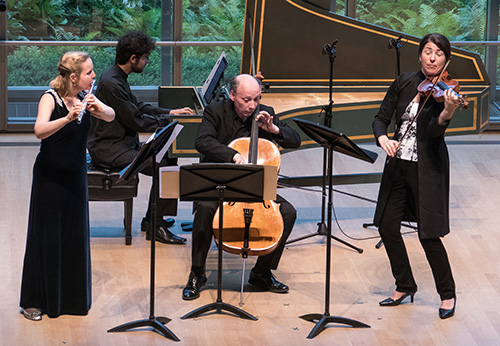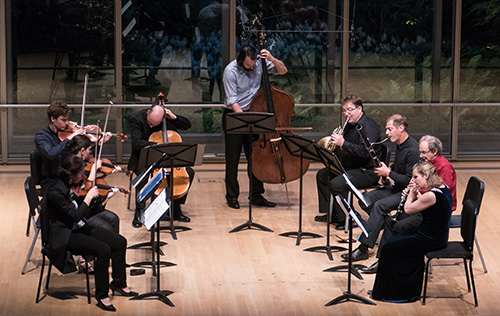by Nicholas Stevens

Subsequent generations have had the same anxieties, but new figures have always emerged to light the way. Each of the composers represented on ChamberFest’s program, Brahms included, faced pushback in blazing their trails. Hats off (as Schumann would have said) to the twelve eminently worthy advocates who brought these composers’ works to the Cleveland Institute of Music’s Mixon Hall on Saturday evening, June 23.
The concert opened with a sensuous rendition of the first movement from Handel’s Trio Sonata in c minor. Gone are the days when modern-instrument renditions of Baroque music tended toward clocklike churning. Violinist Amy Schwartz Moretti and flutist Lorna McGhee gave the overlapping lines of this Andante an elusive, elastic organicism. Cellist Clive Greensmith and harpsichordist Roman Rabinovich laid out a flexible pad of harmonic support, allowing time to expand and contract along with the phrases of the melody instruments.
In the first Allegro, McGhee’s fierceness competed with Schwartz Moretti’s bouncy articulations. The second Andante was as lush as the garden behind the stage’s glass back wall, and the second Allegro offered elements of surprise and moment-to-moment rhythmic nuance. Greensmith played beautifully, but with appropriate restraint.

The second movement, a lively dance, positively grooved — Fejérávi sounded like two virtuosos in one, and Cohen and Caballero traded rapid-fire passages. The third movement found the violinist tackling difficult material with athletic fervor, and Caballero playing bell-up, albeit with tasteful tone. The finale, one of Ligeti’s many lament-style movements of the 1980s, rounds out the piece’s tour through states of movement and human emotion with a striking evocation of the struggle to process loss. When Cohen’s extreme high notes rose above Caballero’s low drones, closure felt distant.

Violist Tanner Menees stood out in a number of early variations. Greensmith consistently provided solid grounding for the group, along with Nathan Farrington, who makes virtuosic playing on the double bass look easy and sound lovely. Schwartz Moretti and Diana Cohen played an interlocking pizzicato passage as though they were one violinist, and later led the string section in ladling out a rich, chocolatey helping of chromaticism.
Some of the variations in the piece’s second half remind us that not all of Brahms’s ideas stand up to the test of time. However, as a demonstration of the composer’s and their own ranges, the performance by these nine players wrapped up the concert in grand fashion.
Photos by Gary Adams.
Published on ClevelandClassical.com June 28, 2018.
Click here for a printable copy of this article



